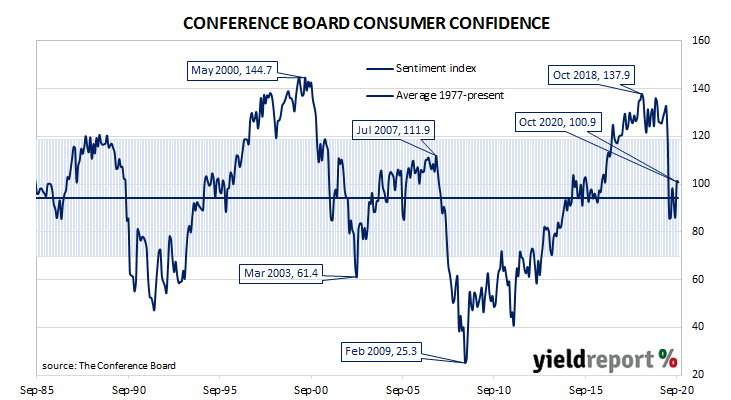Summary: US consumer confidence slightly lower; view of present conditions improves but offset by view of future conditions; little evidence US consumers expect economy to gain momentum.
After the GFC in 2008/09, US consumer confidence clawed its way back to neutral over a number of years and then went from strength to strength until late 2018. Measures of consumer confidence then oscillated within a fairly narrow band at historically high levels until they plunged earlier this year.
The latest Conference Board survey held during the first half of October indicated US consumer confidence was slightly lower than in the previous month. October’s Consumer Confidence Index registered 100.9, below the median consensus figure of 102 and slightly less than September’s final figure of 101.3. Consumers’ views of present conditions improved but their views regarding future conditions deteriorated compared to those held at the time of the September survey.
“There is little to suggest that consumers foresee the economy gaining momentum in the final months of 2020, especially with COVID-19 cases on the rise and unemployment still high,” said Lynn Franco, a senior director at The Conference Board.

Longer-term US Treasury bond yields fell. By the end of the day, the 10-year Treasury bond yield had shed 3bps to 0.77% and the 30-year yield had lost 5bps to 1.55%. The 2-year yield ticked up 1bps to 0.15%.
In terms of US Fed policy, expectations of any change in the federal funds rate over the next 12 months retained a slight easing bias. OIS contracts for November implied an effective federal funds rate of 0.086%, just under the current spot rate.
The Consumer Confidence Survey is one of two monthly US consumer sentiment surveys which result in the construction of an index. The Conference Board’s index is based on perceptions of current business and employment conditions, as well as respondents’ expectations of conditions six months in the future. The other survey, conducted by the University of Michigan, is similar and it is used to produce an Index of Consumer Sentiment. That survey differs in that it also includes some longer-term questions.

